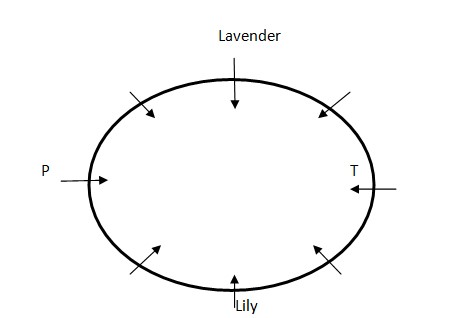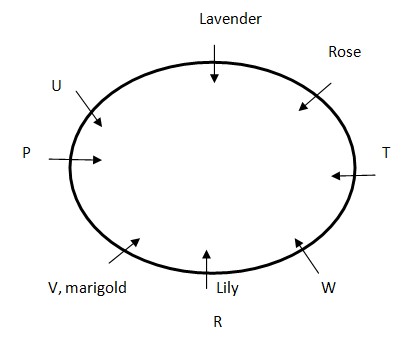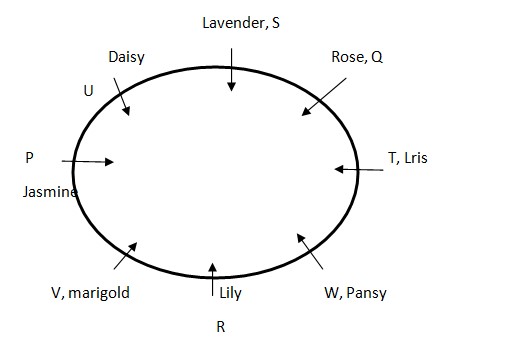Question
Who sits in front of
U? Answer the questions based on the information given below. Eight persons P, Q, R, S, T, U, V and W are sitting around a circular table facing inside but not necessarily in the same order. All of them likes different flowers viz. Lily, Rose, Marigold, Daisy, Jasmine, Lavender, Lris and Pansy but not necessary in same order. Only one person sits between T and the one who likes Lily. P sits second to the left of the one who likes Lily. W is an immediate neighbour of R. R is not an immediate neighbour of P or T and he does not likes Lavender. T sits second to the left of the one who likes Lavender. Only three people sit between the one who likes Rose and the one who likes Marigold. U sits second to the left of the one who likes Marigold. W does not likes Daisy. The one who likes Daisy is not an immediate neighbor of W. S sits on the immediate left of the one who likes Daisy. The one who likes Lris sits on the immediate right of the one who likes Pansy. Only two persons sit between V and the one who has likes Lavender. The one who likes Rose sits second to the right of W.Solution
Only one person sits between T and the one who likes Lily. P sits second to the left of the one who likes Lily. If the one who likes Lily sits at place no.1, then P sits at place no. 7 and T sits at place no. 3. T sits second to the left of the one who likes Lavender. So, the one who likes Lavender at place no. 5.  Only two persons sit between V and the one who has likes Lavender. From this statement, we will have two cases: V will sit either at place no. 2 or 8. W is an immediate neighbour of R. R is not an immediate neighbour of P or T and he does not likes Lavender. The one who likes Rose sits second to the right of W. R cannot sit at place no. 6, 5, 4 and 8. So, only place left for him is place no. 1. As W is an immediate neighbour of R. So, W will sit either at place no. 8 or 2. The one who likes Rose sits either at place no. 4 or 2. Only three people sit between the one who likes Rose and the one who likes Marigold. So, the one who likes Marigold sits either at place no. 6 or 8. U sits second to the left of the one who likes Marigold. So, U sits either at place no. 4 or 6. Case-1
Only two persons sit between V and the one who has likes Lavender. From this statement, we will have two cases: V will sit either at place no. 2 or 8. W is an immediate neighbour of R. R is not an immediate neighbour of P or T and he does not likes Lavender. The one who likes Rose sits second to the right of W. R cannot sit at place no. 6, 5, 4 and 8. So, only place left for him is place no. 1. As W is an immediate neighbour of R. So, W will sit either at place no. 8 or 2. The one who likes Rose sits either at place no. 4 or 2. Only three people sit between the one who likes Rose and the one who likes Marigold. So, the one who likes Marigold sits either at place no. 6 or 8. U sits second to the left of the one who likes Marigold. So, U sits either at place no. 4 or 6. Case-1  CASE-2
CASE-2  W does not likes Daisy. The one who likes Daisy is not an immediate neighbor of W. S sits on the immediate left of the one who likes Daisy. The one who likes Lris sits on the immediate right of the one who likes Pansy. Case 1 will get discarded as the one who likes Daisy cannot sit at place no. 7 and 8. If the one who likes Daisy sits either at place no. 4 or 3, then there is no place for S as S sits on the immediate left of the one who likes Daisy In case 2, if the one who likes Daisy sits at place no. 6, then S sits at place no. 5. The one who likes Lris and the one who likes Pansy sit at place no. 3 and 2 respectively Only person left for place no. 4 is Q. Only flowers left for P is Jasmine Case-1
W does not likes Daisy. The one who likes Daisy is not an immediate neighbor of W. S sits on the immediate left of the one who likes Daisy. The one who likes Lris sits on the immediate right of the one who likes Pansy. Case 1 will get discarded as the one who likes Daisy cannot sit at place no. 7 and 8. If the one who likes Daisy sits either at place no. 4 or 3, then there is no place for S as S sits on the immediate left of the one who likes Daisy In case 2, if the one who likes Daisy sits at place no. 6, then S sits at place no. 5. The one who likes Lris and the one who likes Pansy sit at place no. 3 and 2 respectively Only person left for place no. 4 is Q. Only flowers left for P is Jasmine Case-1  CASE-2
CASE-2  Final arrangement as shown below:
Final arrangement as shown below:
Read the given statements and conclusions carefully and decide which of the conclusions logically follow(s) from the statements.
Statements:
In the following question, a relationship between different elements is shown in the statement followed by two conclusions (I) and (II). Assuming the st...
Statement:
Some Trains are bus.
Only few buses are bike.
Only cycles are bike.
No cycle is plane.
Conclusion:
Read the statement, followed by two conclusions. Read them carefully and select thecorrect option.
Statement: If you are depressed, you are livin...
For a trophy, 16 teams participate, numbered 1-16 according to their rankings. In the qualifier matches, the teams face their immediate next lower ranke...
Read the statements and identify which of the conclusions logically follow/s from the given statement.
Statement:
Parents are ready to p...
Read the given statements and conclusions carefully. Assuming that the information given in the statements is true, even if it appears to be at varianc...
3 In the following question below are given some statements followed by some conclusions based on those statements. Taking the given statements to be t...
Statement:
No one is two.
A few two are three.
Only one is four.
Conclusion:
1. All two being three is a possibilit...
Read the given statements and the following conclusions carefully and select which of the conclusions logically follow(s) from the statements.
S...
Relevant for Exams:


